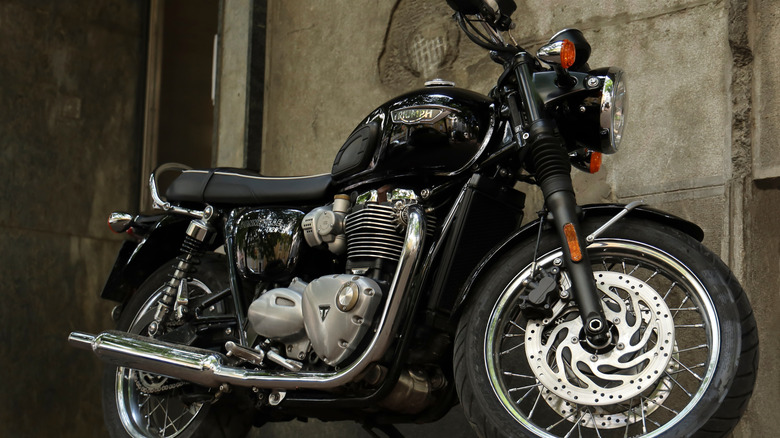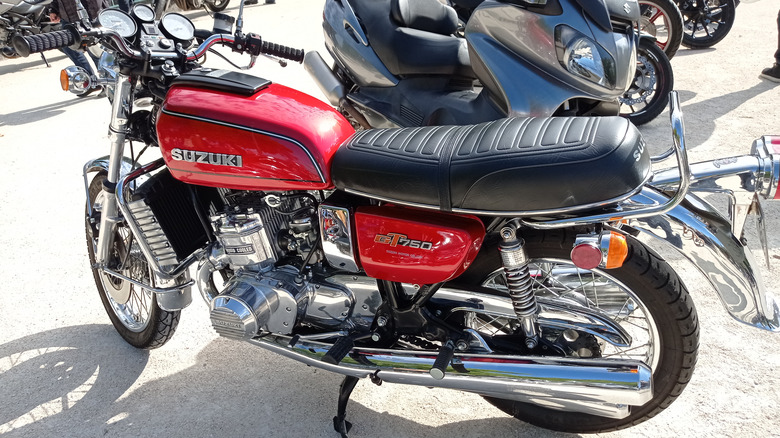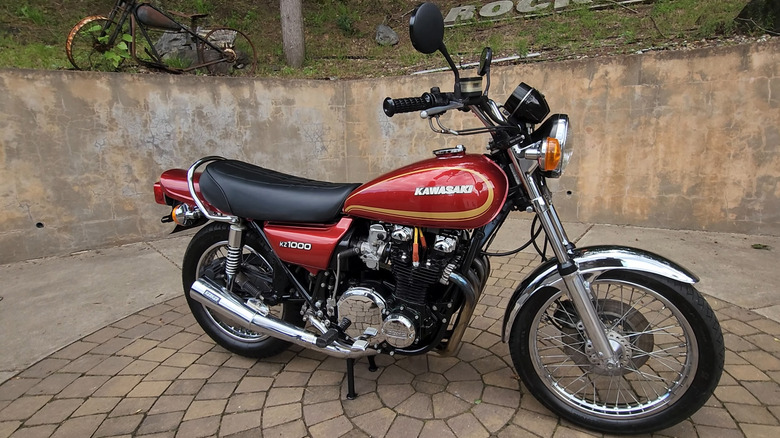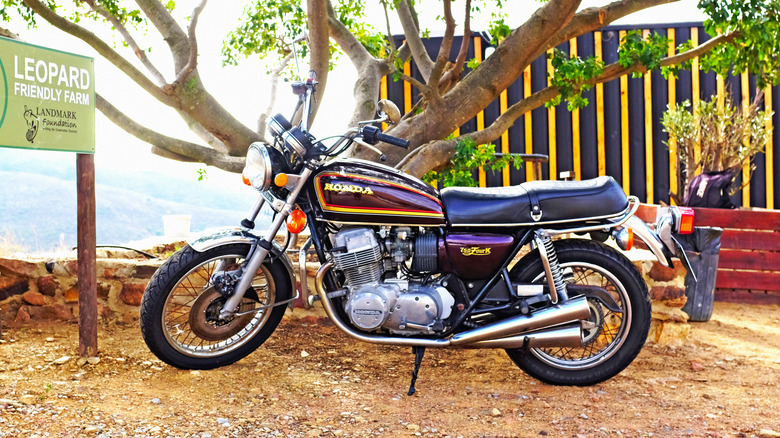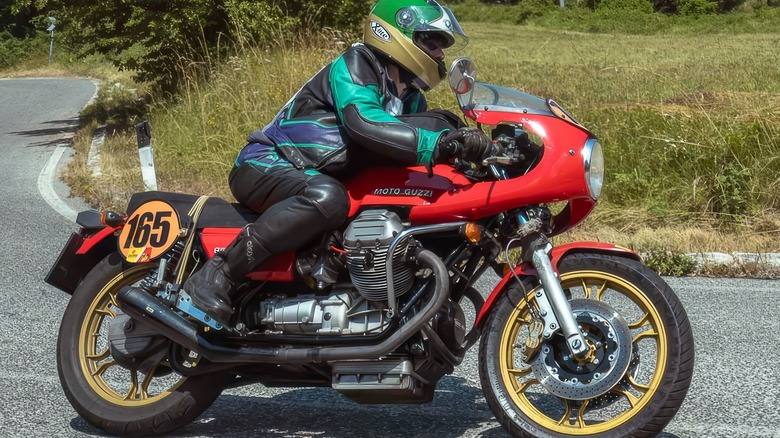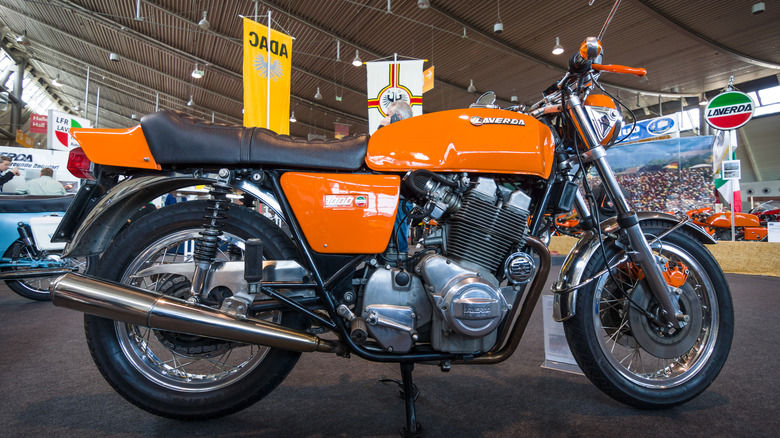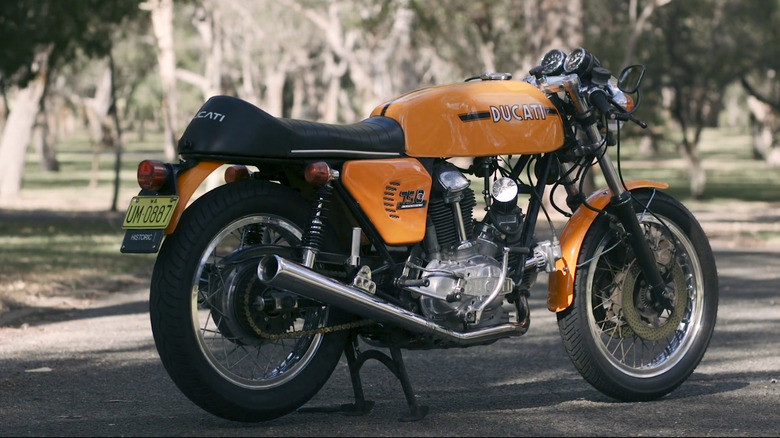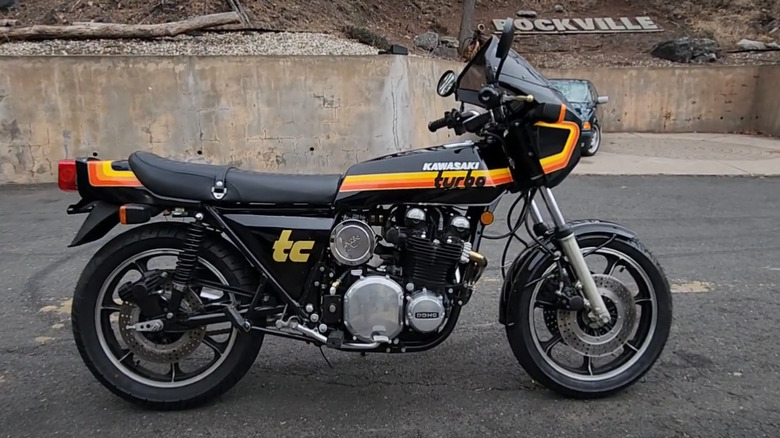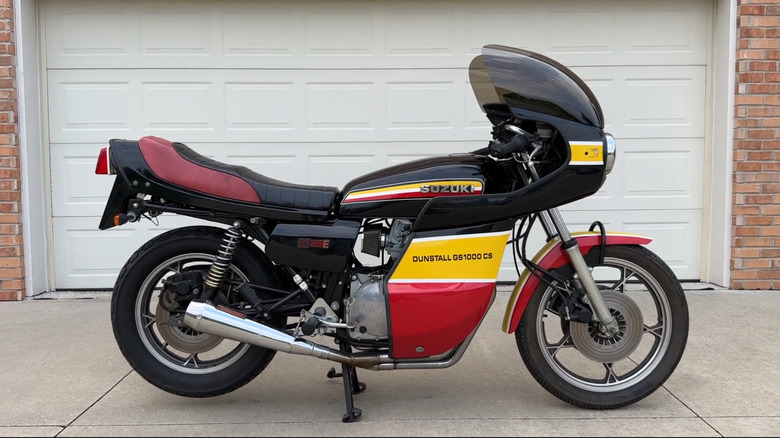11 Of The Fastest Motorcycles From The 1970s
If you've ridden a motorcycle in the 1970s, you know what it's like to ride 600 pounds of barely controlled fury, made by manufacturers who (at the time) considered safety features to be optional. This was the decade when engineers woke up every morning asking: "How can we make our motorcycles even faster and even scarier today?" Every single component was built purely for performance, with rider comfort being damned. This is part of what made these iconic 1970s motorcycles special. Back then, people were obsessed with speed, handling, and looks, rather than safety, assists, and computers, and this clearly shows in the design changes that we see in modern motorbikes.
For instance, today, virtually every new bike comes with rider assist features, safety tech, onboard computers to help with braking, making modern bikes some of the safest motorcycles to ride — and this is a very good thing. However, undeniably, the older-generation bikes were a lot more engaging to ride, as these were raw machines that demanded respect, skill, and a healthy relationship with your life insurance provider. Before we get into the fastest motorcycles of this decade, note that since none of the bikes on this list were particularly high in horsepower, performance varied greatly according to riding position, and the height and weight of the rider.
Here are 12 of the fastest motorcycles from the decade when sanity went out the window.
1975 Triumph Trident -- 110 mph
Starting things off, we have the Triumph Trident from across the pond in the United Kingdom. There isn't much to be said about this motorcycle: it is stunning to look at, comfortable to ride even over long distances, and can hit a top speed of about 110 mph depending on the rider and terrain gradient. The full model name of this motorcycle is the Triumph Trident T160 750, and it came with a pushrod three-cylinder engine that displaced 741 cc, made about 60 horsepower and 45 lb-ft of torque.
However, this already low torque figure only came about at 6,900 RPM which meant that the Triumph could feel underpowered at lower revs, leading to a less enjoyable riding experience for some. This powerplant was paired to a five-speed transmission and featured the best modern tech of the time, namely electric starters, chain final drive, a tubular frame chassis, adjustable preload rear suspension, and a really unique three into four into two exhaust piping layout. The mass-saving frame had the Trident weighing just under 502 pounds, which made this classic motorcycle all the more impressive. It's a pity it didn't really catch on here in the States.
1973 Norton Commando 850 -- 115 mph
Another motorcycle that not a lot of people would remember from the 1970s is the Norton Commando 850 — a four-speed, cafe racer work of art. The Mark one Commando 850 came out in 1973 with four variants and was a direct upgrade to the Norton Commando 750. It is certainly one of, if not the greatest British big twin that ever came to market, and actually has its roots in the legendary Norton Atlas of the mid-1900s, so there is a lot of history behind this motorcycle. In fact, the Commando 850 was so beloved that it was awarded the "MOTY" or "Machine of the Year" award no less than five times in a row by Motorcycle News.
Power for this beautiful bike came from a four-stroke, 828 cc twin-cylinder engine with two Amal carbs, paired to a four-speed transmission. By the time the final Mk 3 generation entered production, the bike weighed about 414 pounds, and made an impressive 48 lb-ft of torque alongside a respectable 60 horsepower, which meant that the "Big Bendy", as it came to be known, could hit a top speed of about 115 mph.
1977 Harley XLH Sportster 1000 -- 110 to 116 mph
The next motorcycle on our list comes from the kings of cruising, Harley-Davidson, in the form of their XLH Sportster 1000, with the 1,000 indicating that the bike now came with a new, higher-displacement 61-cubic-inch (1,000cc) engine. This was quite a substantial upgrade from the 55-cubic-inch (883 cc) engine that the original Sportster used to come with in 1958, which is probably the reason why Harley felt compelled to mention it in the name of their new poster child motorcycle. This was also around the time when Harley began offering electric starters on the XLH Sportster as a standard option, among other bells and whistles.
With the original generation Sportster having already run from 1958 to 1971, Harley felt that an upgrade was long overdue, which is when they released the newer version with the bigger engine, with this Mark II model running until 1985. Harley buffs will know that by this time, Willie G. Davidson (and other old-guard Harley execs) had bought Harley back and introduced the legendary Evolution engine. The Evo engine would blow the competition out of the water but as things stood, the second-gen Sportster with the 1000 cc engine could only manage a top speed of about 115 mph — still an impressive figure for the time, and certainly putting this one amongst the best Harley-Davidson motorcycles ever made.
1971 Suzuki GT750 -- 120 mph
It should be of no surprise to anyone that Suzuki also made several other bikes in the 1970s that happened to be quite fast, and the GT750 is one of them. It was a true pioneer, as it was Suzuki's first liquid-cooled model, and easily became one of the most successful Suzuki motorcycles ever made. Though liquid-cooled engines were not exactly new at the time when the GT750 was launched, they were certainly a novelty feature, because of which the GT750 got some interesting monikers, being called the "water buffalo" in the States, "water bottle" down under in Australia, and "kettle" over in the United Kingdom.
All of these playful takes were poking at the water-cooled engine in some way or another – but bully it all you want, it was plenty fast for the time, able to hit a top speed of about 120 mph despite its heavy bulk of 507 pounds dry, 531 pounds with fluids . The GT750 was, even after a small but important refresh in 1975, still up against stiff competition, courtesy of the heavy-hitting H1 from Kawasaki, the CB750 from Honda, the Norton Commando, and the Harley-Davidson Sportster. By the end of its production cycle, the Suzuki GT750 was making a modest 70 horsepower and 61.5 lb-ft of torque, despite all of which it still clocked a standing quarter-mile time of just 12.6 seconds.
1978 Kawasaki Z1000 -- 120 to 125 mph
The Kawasaki Z1000 is also a pretty impressive 1970s motorcycle, clocking a top speed of about 120 to 125 mph, depending on the rider profile. Depending on where it was sold, this bike would have either been called the Z1000 A2 in Europe and Australia, or the KZ 1000 here in the States, but either ways it came with a beautiful 61.9-cubic inch (1,015 cc) transverse, DOHC, four-cylinder engine that produced 82 horsepower and 59 lb-ft of torque — plenty enough for a motorcycle that weighed only 240 kilograms(529 pounds) without fluids. Also, note that while we're officially including the Z1000 A2 on our list, it isn't too different from the Z1000 A1 that debuted just a year prior in 1977.
When launched, the company was being edged out by larger-displacement models from both Suzuki and Honda, so they had to bump up the engine displacement on their much-loved Kawi Z900 model, which is how the Z1000 A2 was born. Then, the Z1000 A1, as the 1977 model was known, faced teething problems like master cylinder bleeds, carburetor issues, and starter unreliability that were swiftly addressed in the following year, with the release of the new Z1000 A2 in 1978, and the rest is history. Today, you can snag a pretty decent KZ1000 for about $5,000 on the used market and though vastly underpowered by today's standards, it's still a fantastic bike suitable for both beginner riders as well as advanced stables.
1970 Honda CB750 -- 125 mph
The Honda CB750 is an easy inclusion among the most stylish Honda motorcycles ever designed, and it's next on our list. In an era when numbers were the priority, the CB750 had it all: a 14-second quarter-mile time, a respectable top speed of 125 mph, decent acceleration, impeccable looks, and a not-too-ludicrous base MSRP of about $1,895. At launch, this beast would have certainly been one of the most futuristic motorcycles on the market, perhaps in history. And while its main competitor, the Suzuki GT750 did improve the quarter mile by a solid 10 percent (12.6 seconds for the Suzuki versus the Honda's 14 seconds), the Honda speedo would still show an impressive 96 mph by the end of the quarter-mile strip.
Also, it's worth noting that the Honda CB750 debuted in 1969, two years before the Suzuki GT750 would come onto the scene in 1971. With the success of the initial models, Honda would then go on to release a couple more versions based on the same platform, such as the CB750 four-KZ, which kept a lot of the original design, including the four different exhaust pipes housed in four mufflers – two on either side of the bike. Other notable features on (most) CB750 models include an electric starter (in addition to a kick-start lever), four Keihin carbs to match the four cylinders, a five-speed transmission, and classic instrumentation — namely a tachometer and speedometer that reads up to 150 mph.
1975 Moto Guzzi Le Man Mk1 - 130 mph
One of the "old guard" as far as racing/sport motorcycles go, Moto Guzzi's Le Man bike is the next one on our list, one that is also one of the most incredible motorcycles in Ewan McGregor's collection. When people write about motorcycles, they tend to have particular "categories", such as "cruiser", "touring", "motocross", and it was no different when the Le Man debuted. However, this was one bike that you could not put your finger on — was it a cafe racer? Was it a city runabout? Perhaps it would be better classified as a sportbike, but the truth is the Moto Guzzi Le Man was whatever you, the rider, needed it to be. With a top speed of 130 mph, it would certainly hold its own on the open highway, and with a plush leather seat and relaxed riding position, it was absolutely usable as a commuter.
The looks hold up even today, turning heads wherever one of these things goes. The Mark One generation Le Man was unveiled in Milan in 1975, and the mark two followed three years later, in 1978. The Mk II brought about a number of improvements such as a new aerodynamic profile that was developed in a wind tunnel, an all-new instrumentation panel, and other bits and bobs. Despite this, many experts maintain that the first generation Moto Guzzi Le Mans Mk I is the more desirable version of the two.
1976 Laverda 1000 3C - 140 mph
One of the fastest bikes on this list, the 1976 Laverda 3C is actually not that well known, even in enthusiast circles. It came onto the scene in 1974, putting it squarely into competition with the heavyweights from Suzuki, Honda, and, of course, Kawasaki. The 1000 3C was manufactured and designed by an Italian house that didn't have the budget or the road-slash-racing experience of the big Japanese houses. In fact, Laverda's motorcycle division was behind on all major fronts – design, engineering, technology, manpower, as it used to be a company that used to make agricultural equipment and wine machinery.
After World War II, the Laverda factories survived, and the owners decided to pivot into motorcycle manufacturing, as bikes were really catching on at the time, though they lacked experience. Despite all that, the Laverda 3C still managed to compete with the legacy companies on top speed. Powered by a 981 cc, three-cylinder engine with dual cams, the Laverda 1000 3C made a sizeable 78 hp and 63 lb-ft of torque, while weighing 472 lbs –- all of which meant that it could comfortably reach its top speed of 140 mph, a super impressive figure for the time.
1974 Ducati 750 Super Sport -- 140 mph
Whenever a list is created about fast bikes, there's bound to be a Ducati on it, and this one is no exception. The model we've chosen is the 1974 Ducati 750 Super Sport that was intended to compete with the Honda CB750 and Suzuki GT750, as all three of these bikes had engine sizes, top speeds, and quarter-mile times that were very close to each other ( 14.0, 12.6, and 12.4 seconds for the CB750, GT750, and 750 SS respectively). The Ducati 750 SS came with (arguably) the most iconic Ducati engine of all time – the Desmo Twin. This was a 748 cc monster that churned out 70 horsepower from two cylinders mounted at 90 degrees, mated to a five-speed transmission.
All of this, coupled with the fact that it weighed just 400 pounds, meant that the 750 SS could hit a very impressive top speed of 140 mph. One unique aspect about the 750SS was that it had this strip of clear plexiglass on the gas tank itself that could quickly give you an indication of how much fuel was left at a quick glance, and served as a talking point too. All of these design decisions were taken under the guidance of the technical director of Ducati at the time, Fabio Taglioni, a man who was responsible for putting out amazing machines like the Gran Prix, Desmo, and 500 Gran Sport, so it's no surprise that the 750 SS is so desirable.
1978 Kawasaki Z1RTC - 145 mph
Arguably the most legendary motorcycle on this list, this next model also comes from Japan – and we specifically want to include the 1978 model, which actually hit 145 mph in testing. A fun history tidbit is that when the 1978 Kawi Z1 R-TC was pitted against a 1978 Porsche 911 Turbo, it actually came out the winner. It had a faster quarter-mile time (10.7 seconds versus the Porsche's 13.9 seconds), and at the end of the quarter-mile, the Z1 was clocked at 133 mph, while the Porsche had only ambled up to 102 mph. All in all, it was a very cool bike, with a surprising amount of history behind it that only the most entrenched motorcycle buffs know.
The 736.5cc Honda CB750 had established the "superbike" class in 1969 when it was launched, and Kawasaki was scrambling to come up with a machine that could compete. Come up with a competitor they did, in the form of the 1973 Z1 R-TC that had debuted to the public a year earlier — and it absolutely blew the CB750 out of the water, at least on paper. It had a 903 cc turbocharged inline-four engine with dual overhead cams that was rated for 82 horsepower and 54 lb-ft of torque. All of this power and grunt resulted in the Z1 breaking over 45 different records upon its debut, making it the world's most desirable bike at the time.
1979 Dunstall Suzuki GS1000CS - 145 to 150 mph
The Suzuki GS series remains one of the few classic motorcycles that are still affordable for now — and it's actually quite surprising why they aren't more expensive. For between $4,000 and $7,000, you get fantastic build quality, amazing looks, Japanese reliability, and some extremely performant classic bikes – and that's across the entire GS range, from the 750, up to the 1100. However, the one we want to mention is the Dunstall-Suzuki GS1000CS — a motorcycle that you will have a very hard time finding in America. This particular model was a "regular" Suzuki GS1000, but with a bunch of aftermarket parts installed by Dunstall — with Suzuki's approval, and only a few were ever sold.
The Dunstall modifications included the addition of a 29-millimeter Mikuni carburetor, changes to the frame, different muffler, and several other aesthetic changes. All of these changes translated to an impressive top speed of 231 kmph (150 mph), which, for reference, is about 40% faster than the Harley XL 1000 Sportster that we covered above. We should also mention that while any GS1000 in good condition is a rare find, the Dunstall GS1000s (the GS1000CS or the GS1000XT) is even rarer, with only 200 kits having been produced, of which we don't even know how many remain.

